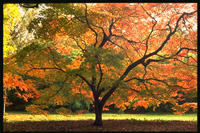Click on image for full size
Corel photography
Related links:
Mother Nature's Air Conditioning
News story originally written on July 11, 1997
J.S. Maini of the Canadian Forest Service has referred to forests as the "heart and lungs of the world." Forests reduce soil erosion, maintain water quality, contribute to atmospheric humidity and cloud cover, filter air and water pollution, absorb carbon dioxide, release oxygen, and maintain animal life. But forests are not only the heart and lungs of the world, they are its central air conditioning unit!
In fact, NASA researchers are studying how "urban forests" may help keep our cities cool. There are bubble-like accumulations of hot air, called urban heat islands, over all of our growing cities. Urban heat results when humans replace vegetation with material such as asphalt and concrete. These man-made materials can be 20-40 degrees hotter than those of vegetated surfaces. "This produces a dome over the city of temperatures 5-10 degrees higher than air temperatures over adjacent rural areas," said Dr. Quattrochi of NASA. "The more a city grows, replacing trees and grass with buildings and roads, the warmer it becomes, increasing peak power demands. To meet these demands, power plants must utilize fossil fuels to a greater extent, which ultimately has a negative impact on air quality," stated Dr. Luvall, also with NASA.
Dr. Quattrochi and Dr. Luvall are basing their study on the city of Atlanta, Georgia. A Lear jet equipped with thermal imaging equipment flew over Atlanta on May 11 and May 12 taking heat images that will help determine where Atlanta's hot spots are located. Images were taken at mid-day, the period of maximum heating, and 12 hours later when surfaces began to cool.
The findings from this experiment will show how tree cover affects Atlanta's temperature and air quality. Hopefully, this information will urge urban planners across the world to develop and maintain their urban forests.














